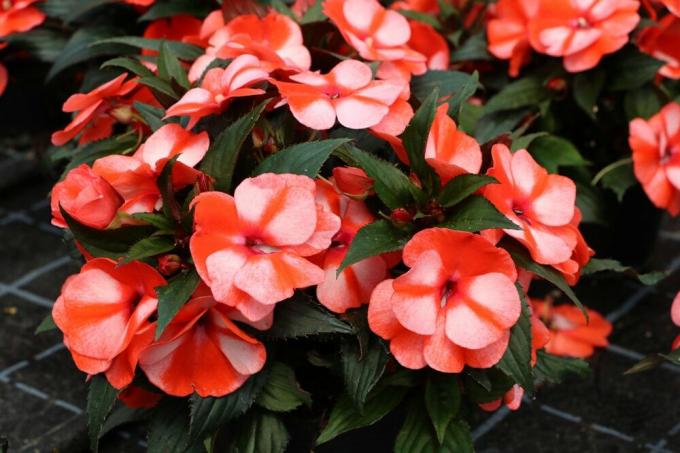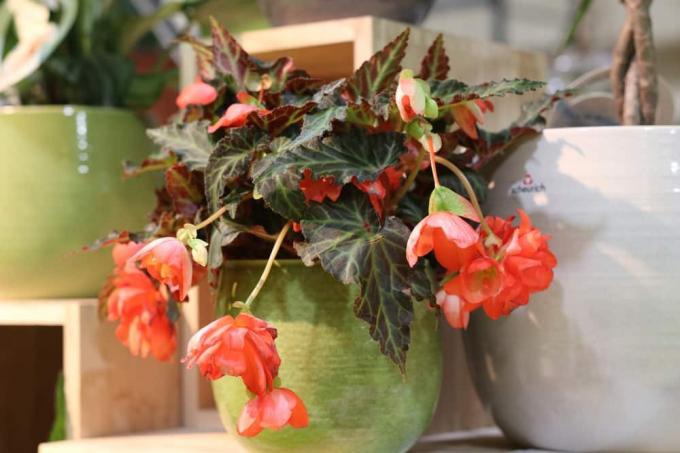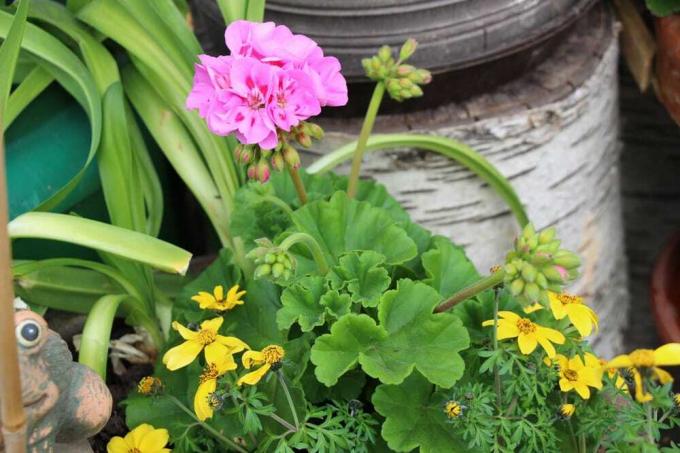

Table of contents
- Overwinter indoor begonias
- Overwintering outdoor begonia
- tips
- Easy to care for begonias over the winter
- substrate and soil
- watering and fertilizing
- diseases and pests
- sowing
- frequently asked Questions
- Worth knowing shortly
- as a houseplant
- outdoors
- wintering
The blooming wonder of the summer is the begonia. It is one of the classics among garden plants, but also indoor plants. Their original home is the tropical rainforest. Today, in our gardens in pots or outdoors, it is an easy plant to mix with different crossings in many color variations and patterns on the home balcony, terrace and also in living rooms feels good. If the begonias are to be overwintered, there are a few things to consider.
Overwinter indoor begonias
The plants can be overwintered warm, for example in the living room. If the begonia is a little cooler, you can enjoy its flowers longer. However, the plants should not be placed near radiators. Care should be taken with the plant substrate that it does not get too wet, but the plant must not dry out either. Since the moisture damages the begonia, it should not be watered too much. When hibernating, the begonia does not like to be too dark, but the south-facing window is not the right place either. It should not be placed on a window sill under which there is a radiator.
Overwintering outdoor begonia
Begonias should be removed from the bed after the leaves have fallen. If there are still leaves, they are shortened to 2 centimeters. The plant should definitely be brought in before the first frost, they are very sensitive to frost. You can hibernate it if it is placed in a dry and loose plant substrate. This requires a frost-free room, for example in the basement. It does not need light, the temperatures are ideally around 10 degrees. Potted plants, on the other hand, can remain in the pots in the substrate, but here the rule is to keep them dry and frost-free. The tubers must not be too damp, a light spray now and then is perfectly sufficient. The following year, in February or March, the tubers can be planted again. Then it can also be watered moderately. The plant should be placed a little warmer in the early part of the year. When overwintering the begonias, it is very important that the room is ventilated regularly. If new leaves form, you can fertilize again. After the ice saints, they can be set or placed outdoors.
tips
- When planting begonia bulbs, make sure the bulb's hollow side is up, it just gets covered with less soil.
- If you don't have that much space, you can also take the begonias out of the pot or the ground for the winter.
- If the plant overwinters in an air-dry room, it should stay in the pot so that it cannot dry out completely. Here too, spray with water from time to time.
- If you are generous with the water, you should better take the tuber out of the ground.
- If the outdoor begonias are overwintered in a warm room, they will sprout too early and wither.
Easy to care for begonias over the winter
begonias or their tubers freeze at 0 °C and are overwintered frost-free. It should be noted that watering is already done more sparingly at the end of September. This causes the leaves to slowly wither and the plants to dry out. This process draws the energy reserves from the leaves into the tubers. If the begonias are in bloom for too long, they will lose vigor and will therefore bloom more weakly in the following year.

The begonias can be overwintered in the basement to save space. It should be brought into the house or the wintering room before the first frost and cut back hand-high. Check for pest or rot infestation and clean out infested plants or parts of plants. A dry substrate, newspaper or sand is good for the plant and it can overwinter in it. The room should be dry and frost-free and have a temperature of 8 °C.
substrate and soil
When the begonias come outside again after the ice saints, the soil should be nutrient-rich and permeable. Like other flowering plants, the begonia needs a lot of nutrients. However, she does not like waterlogging, which causes the tuber to rot. It is therefore important that the soil is permeable. The begonia does not like clay soil. But if there is only clay soil, sand must be mixed in.
- well-drained soil
- sufficient nutrients
- Mixture of humus soil and sand 1:1 is good
watering and fertilizing
If you give your begonias too much water, you will do more damage than not enough.
Tip:
There are balcony boxes with an irrigation system, so the plant can go a week without water.
However, the bale should not be completely dried out. When the temperatures are high, watering can be forgotten for a day. The plant likes regular and moderate watering. Since it is sensitive to waterlogging, the top layer of soil should be well dried before watering again. Never leave liquid in the cachepot to prevent this, it is best to set it up without a cachepot. When watering, avoid watering over the leaves and flowers. At the end of August, less watering is announced so that the leaves have withered by autumn. Fertilize every 14 days with a liquid fertilizer for flowering plants during the flowering period.
diseases and pests
Begonias are susceptible to fungal diseases, including powdery mildew and gray mold. This forms when the plant is kept too moist. Remove all affected parts and spray with a mixture of water and milk, using one part whole milk and nine parts water. Pests are not that common, sometimes aphids appear, which can be fought with a detergent solution. Worse are actually the leaflets that can destroy an entire plant. If soft skin mites are found, give the plant a good shower, but first make the pot waterproof.
sowing

The seed of begonia is very small. When sowing, you should make sure that not too many are sown next to each other. If you sow in December, you can already enjoy the flowering plants from mid-May.
frequently asked Questions
Begonias grow and thrive in part shade and shade and do not like direct sunlight.
Cuttings are cut early in the growing season, in spring through early summer. You can root them in a glass of water, but also in the ground. Once enough roots have formed, they can be planted in the ground.
If the begonia is growing vigorously and the pot is too small, you can carefully repot it. But you should make sure that the roots, flowers and leaves are not damaged.
Worth knowing shortly
as a houseplant
- As a houseplant, the begonia needs a lot of water. As a rule, replenishment is needed when the top layer of soil has dried.
- When watering, the leaves and flowers must not be watered. Despite the high water requirement, waterlogging must be avoided.
- Good drainage is therefore absolutely necessary. The irrigation water is every two weeks in the flowering period fertilizer to add.
- In winter, the room should be kept at a good level of humidity: either with the help of a humidifier or by misting it every day.
outdoors
- Outdoors, the begonia definitely does not want a place where it is fully exposed to the midday sun.
- Otherwise, their leaves and flowers would burn. In the meantime, however, there are also species specially bred for a location in the sun.
- The rule of thumb for semi-shady species is no direct sunlight from 10 a.m. in the morning to 5 p.m. in the afternoon in summer.
- As with indoor plants, outdoor begonias always want to have enough water available.
- In pleasant weather, watering 2-3 times a week is sufficient.
- Since it is often difficult to fertilize regularly at intervals of 1 - 2 weeks, the addition of a storage fertilizer is recommended.
- Outdoor begonias can be enjoyed for several years. Unfortunately, they are not resistant to frost.
wintering
- If the begonias are in the bed, the tubers should be dug up after the leaves have fallen.
- These are then placed in a dry, loose substrate and placed in a frost-free room.
- If the begonias are in a container, you can just as easily put them in a frost-free room over the winter.
- In this case, it is not necessary to dig up the tubers.
- With both types of overwintering, it is important to ensure that the tubers are kept as dry as possible to prevent rot.
- In spring (February/March) the tubers are put back into the bed and watered sufficiently.
 garden editorial
garden editorial I write about everything that interests me in my garden.
Learn more about balcony plants

Eisbegonia, Begonia: care instructions from A - Z
The ice begonia is one of the most popular bedding plants, because they are characterized by their robustness and willingness to flower. When caring for ice begonias, there are a few points to consider when fertilizing and watering. As a houseplant, it is perennial and can be overwintered.

Begonia location: 3 important criteria
Begonias are easy-care plants. However, so that they can thrive and you can actually enjoy them, the location must be right. And that means above all: no direct sunlight, but shade or semi-shade. In addition, the soil should be as moist as possible.

Blue fan flower, Scaevola aemula: care from A - Z
Are you looking for an easy-care and robust flower for the balcony? Then the blue fan flower might just be the right plant for you!

16 popular hanging plants and how to care for them
Hanging plants aren't always a sad sight. At least not when nature intended it that way. Their tendrils weave a new dress on boring balcony walls in no time. Whether fast-growing, green, colorful or just easy to care for, every wish will be fulfilled.

13 balcony plants for sunny south-west balconies balcony flowers
A balcony with leafy or flowering plants delights both the heart and the eye. However, not every balcony plant is suitable for every balcony, because every plant makes specific demands on the location. We have put together for you which plants are particularly suitable for a south-west balcony.

Scented geraniums: care, propagation and overwintering scented geranium
Is it the lush growth? The brightly colored flowers? Or is it its beguiling scent that makes the scented geranium our favourite? Does she have any other trump cards? Yes! As beautiful as she is, she is also undemanding. Your care succeeds!



